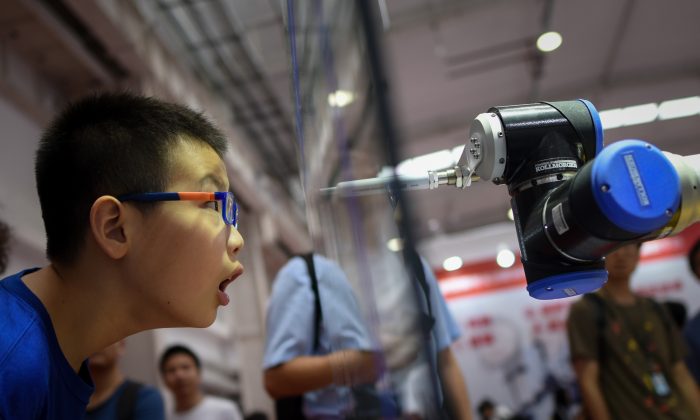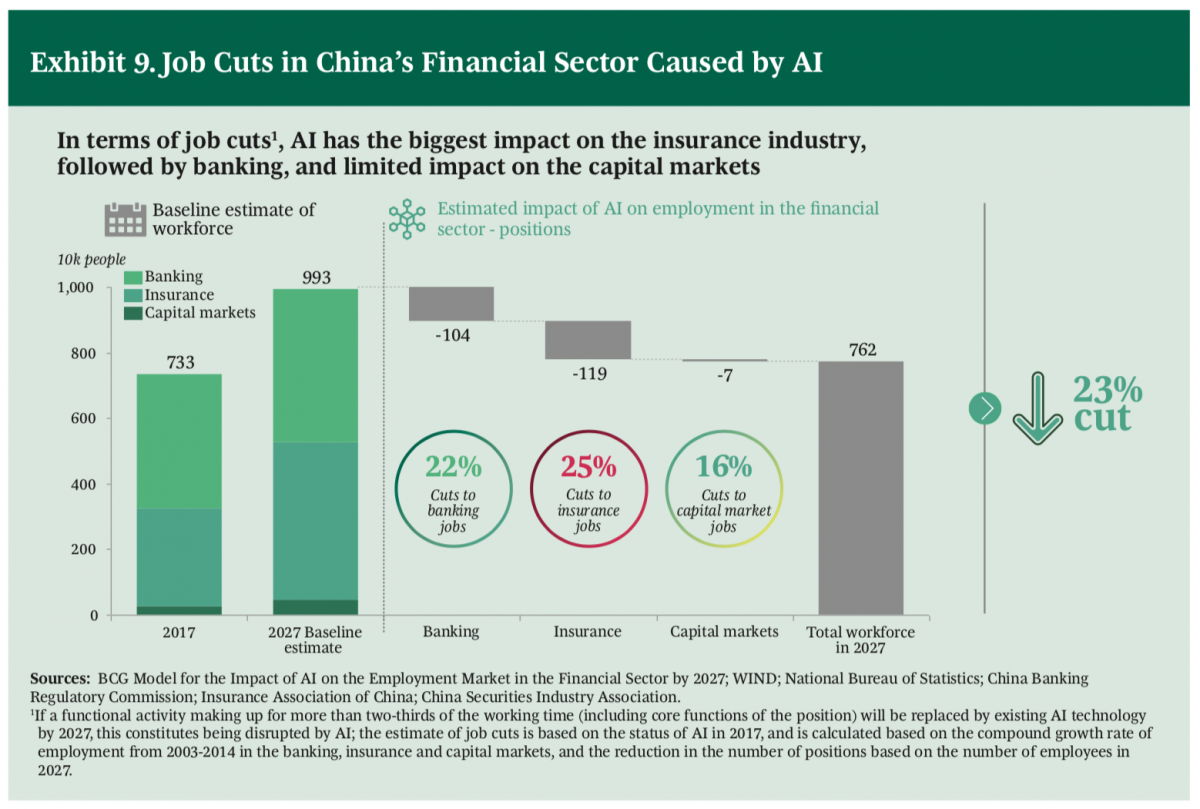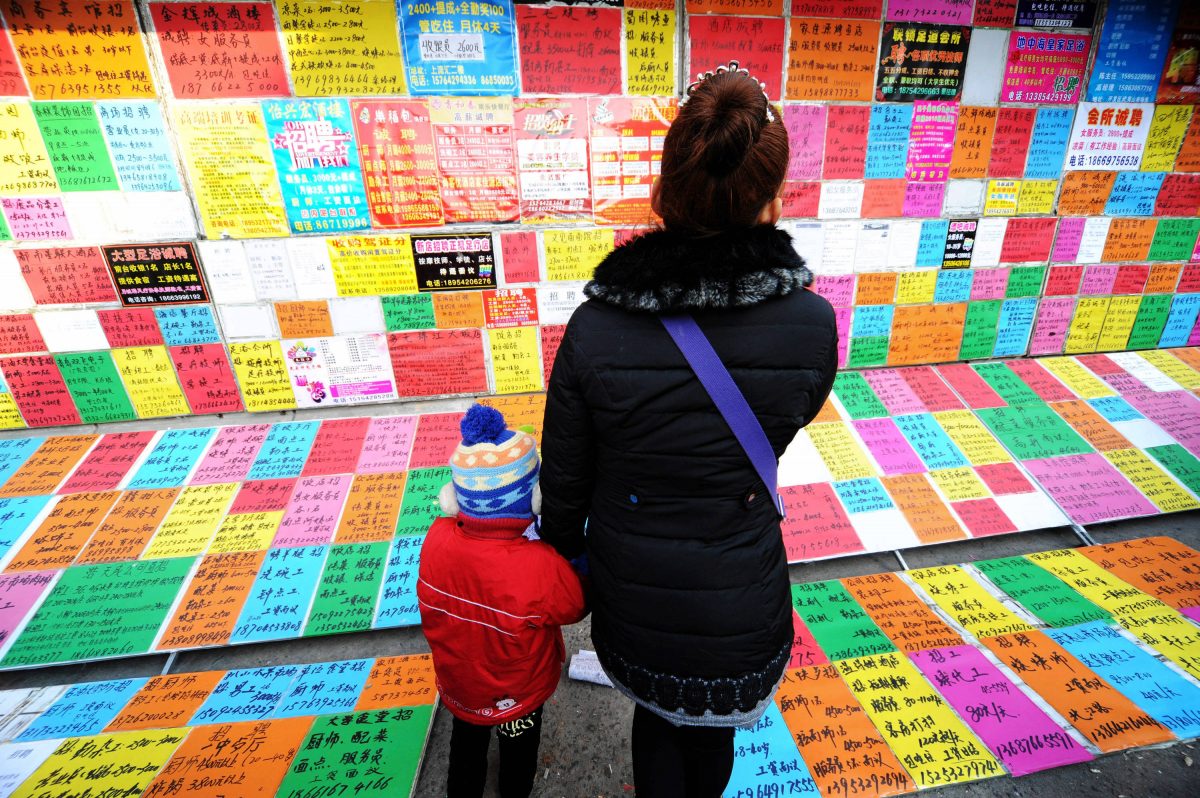
A boy looks at a robot arm at the 2018 World Robot Conference in Beijing on Aug. 15, 2018. (Wang Zhao/AFP/Getty Images)
Technology Advancements Are Double-Edged Sword for China
China aims to become the global leader in automation, artificial intelligence (AI), and robotics. It’s a goal set forth in its “Made in China 2025” program and reiterated during each economic-policy update.
But, in achieving those goals, there will be collateral damage, which has already manifested in the country’s manufacturing sector, the backbone of China’s economy.
In Beijing’s efforts to pursue an ambitious technological agenda, the narrative from state-run media and authorities have concentrated on the positives. In reality, automation has already replaced up to 40 percent of workers in some Chinese industrial companies, including “several companies in China’s export-manufacturing provinces of Zhejiang, Jiangsu, and Guangdong,” according to an Aug. 30 Financial Times report.
Quietly, Chinese authorities are concerned about the long-term impact of such layoffs on social—and ultimately, political—stability.
100 Million Workers
The rapid development of AI and automation will permanently change China’s employment and economic landscape.
Around 40 million to 50 million workers will be replaced within the next 15 years, and almost 100 million workers will need to change their field of work, according to a recent research report released jointly by the China Development Research Foundation (CDRF), a government-controlled think thank, and Sequoia Capital China, China arm of the Silicon Valley venture-capital firm, and cited by the China Daily, an official media outlet.
“If we decide to go on the path towards a future with AI, we must emphasize human capital investment, and this must be done at an early stage,” Lu Mai, vice chairman and secretary general of CDRF, said at the release of the report.
“Actions should be taken as soon as possible to address these potential challenges.”
While the new report focuses on the manufacturing sector, it echoes the conclusions reached in a March report—published jointly between the CDRF and consulting firm Boston Consulting Group (BCG)—on the impact of AI on the financial-services industry in China.
In that report, BCG estimated that by 2027, 23 percent of all jobs in China’s financial sector will either be cut or transformed to a position requiring a different skillset. Insurance companies will be the hardest-hit, with 25 percent of jobs affected, followed by banking (22 percent), and capital markets (16 percent). In total, that translates to about 2.3 million full-time financial jobs displaced, using 2017 sector employment levels.
Advancement in AI will affect jobs in almost every sector in every country, but China’s existing political framework and employment structure are especially vulnerable to the effects of automation.

A Black Box
First and foremost, the topic of unemployment itself is taboo and isn’t well understood. Unlike the monthly figures released by the U.S. Labor Department—a key lagging indicator for the U.S. economy—Chinese unemployment figures have been mostly useless.
At a macro level, China has historically underreported its unemployment rate. Politics is the main culprit; until the mid-1990s, the Chinese Communist Party (CCP) denied the very existence of unemployment, viewing it as a negative side effect of foreign capitalism.
But as the country’s economy liberalized and Deng Xiaoping reformed state enterprises in the 1990s, Beijing had to recognize unemployment and began offering limited benefits to displaced workers.
For decades, China’s unemployment rate hovered around 4 percent, because the statistics counted only those urban workers who were able to file and be approved for unemployment benefits. But the figures were unreliable, because they didn’t count China’s approximately 300 million migrant workers, and didn’t include those urban workers who weren’t approved for unemployment benefits.
This year, China began publishing a quarterly “Western-style” Surveyed Unemployment Rate—still only limited to urban areas—in addition to the established Registered Unemployment Rate. In the second quarter of 2018, the surveyed rate was 4.8 percent while the registered rate was 3.8 percent.
On paper, both of those rates were well below the target 5.5 percent and 4.5 percent, respectively, set forth by the National People’s Congress in March.
Then why did the Politburo recently announce “stabilization of the unemployment rate” as No. 1 of the top six targets in the second half of 2018?
Of all the economic difficulties such as trade, currency, and non-performing loans, the Politburo curiously singled out employment. Reading between the lines, there must be underlying domestic complications beyond the officially printed unemployment rate.

Structural Problems
It’s difficult, and inadvisable, to generalize China’s complex and evolving labor environment.
There are several dynamics playing out, which are further complicated by the advancement in automation and AI.
Due to the CCP’s historical policy of protecting employment and state-ownership of most large enterprises, Chinese employers are typically less efficient than their Western counterparts. This means that Chinese firms could experience a larger hit from automation compared to Western peers.
Joblessness has also been increasing recently, due to closure of large industrial plants in China’s Northeast “rust belt,” factories moving out of Eastern and Southern China to lower-cost regions in South Asia, and Beijing’s efforts to rein in excessive debt which slows economic expansion.
The CCP’s role as a job creator has also invited criticism when jobs are lost, causing pockets of unrest and protest across the country. Authorities have increased efforts to crack down on labor protests, but the recent trend of retired military veterans joining such protests should be worrisome for the CCP.
As for the impact of AI, economists hope that technology will create new fields and in the long run, employment will even out.
“If we go back to the early 19th century, there were worries about mechanized spinning machines and the idea that this would put large numbers of people out of work,” Goldman Sachs Chief Economist Jan Hatzius said in a late-2016 research note on AI. “In the short run, that disruption is something that can have a significant impact.
“But it’s not the case that technological progress over the longer stretch of history has led to higher unemployment rates. That is not the case.”
In other words, new technologies and industries will create new jobs to even out unemployment over time.
But for the Chinese Communist Party, obsessed with social stability, time is also the scarcest resource.
No comments:
Post a Comment
Comments always welcome!